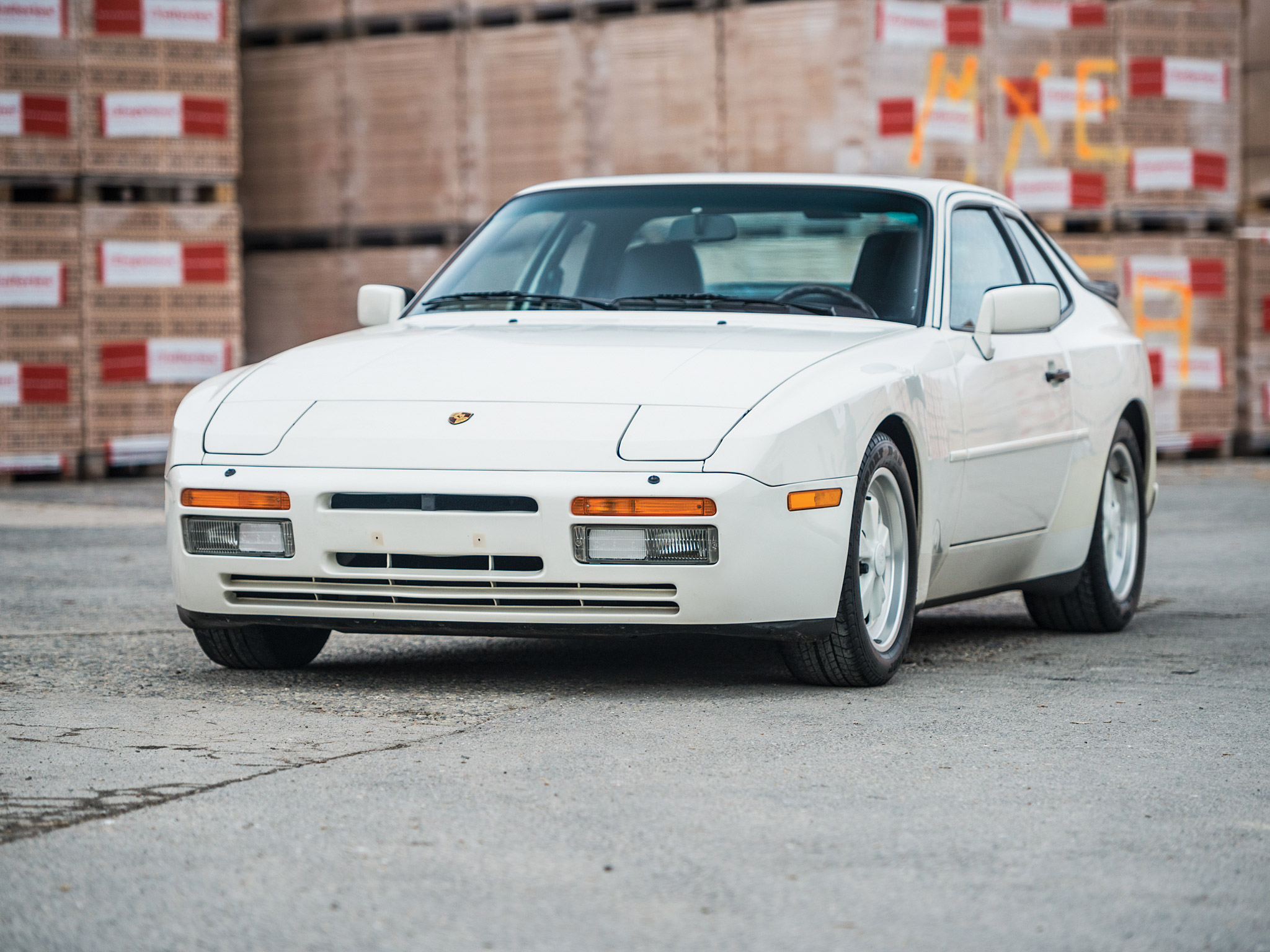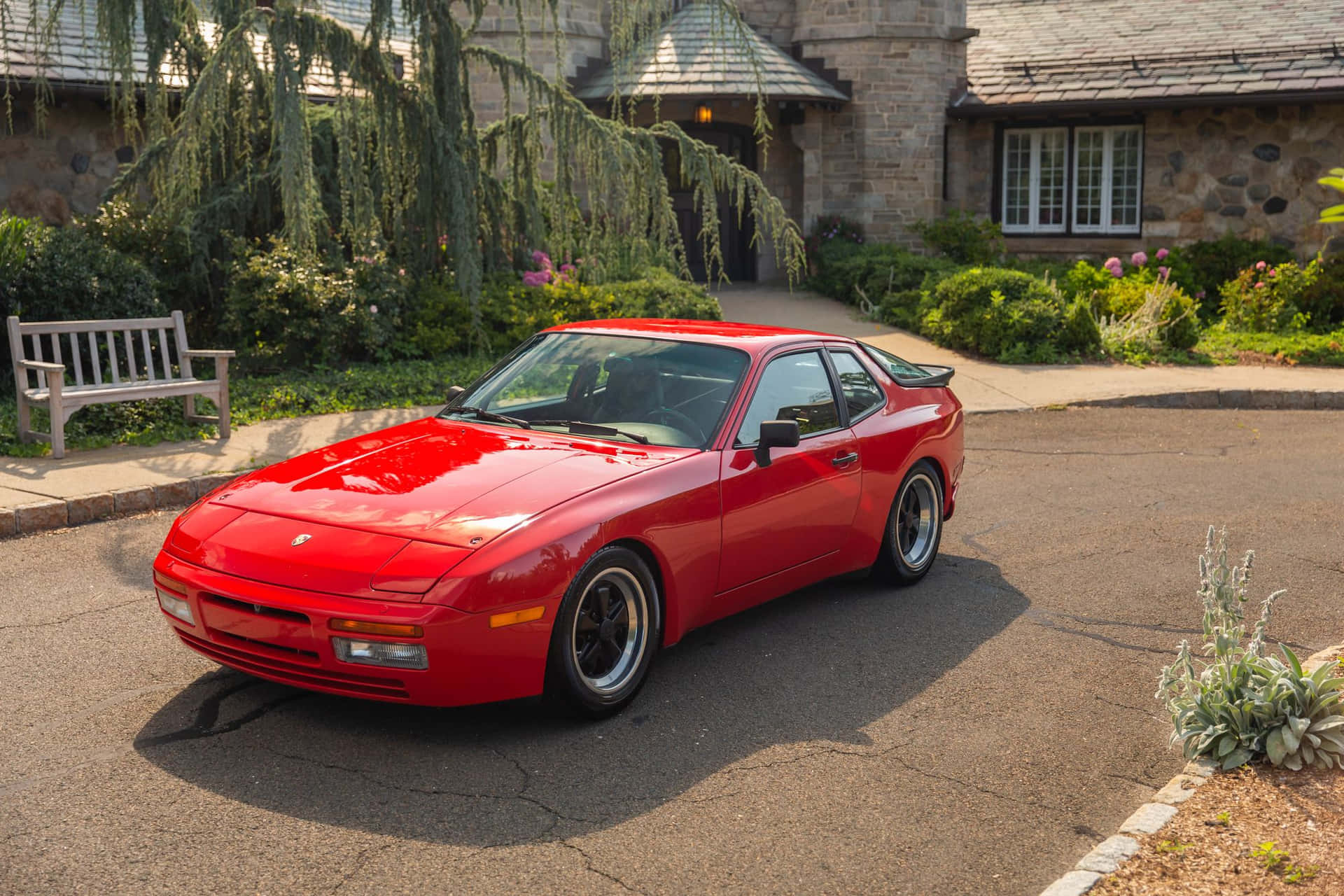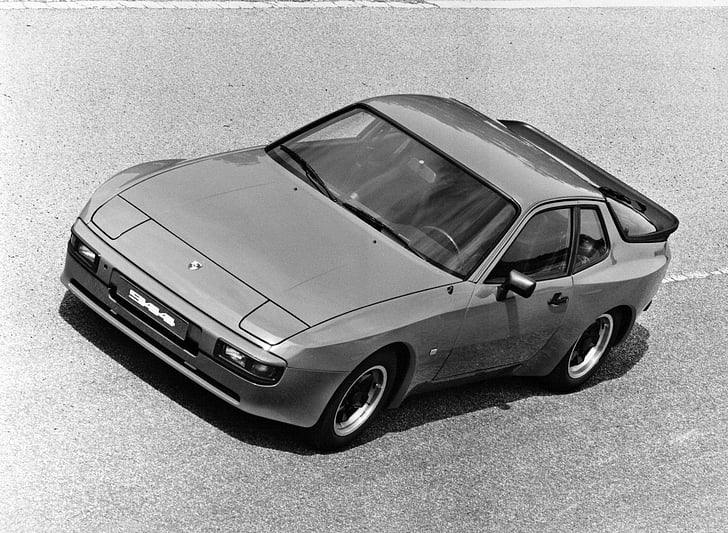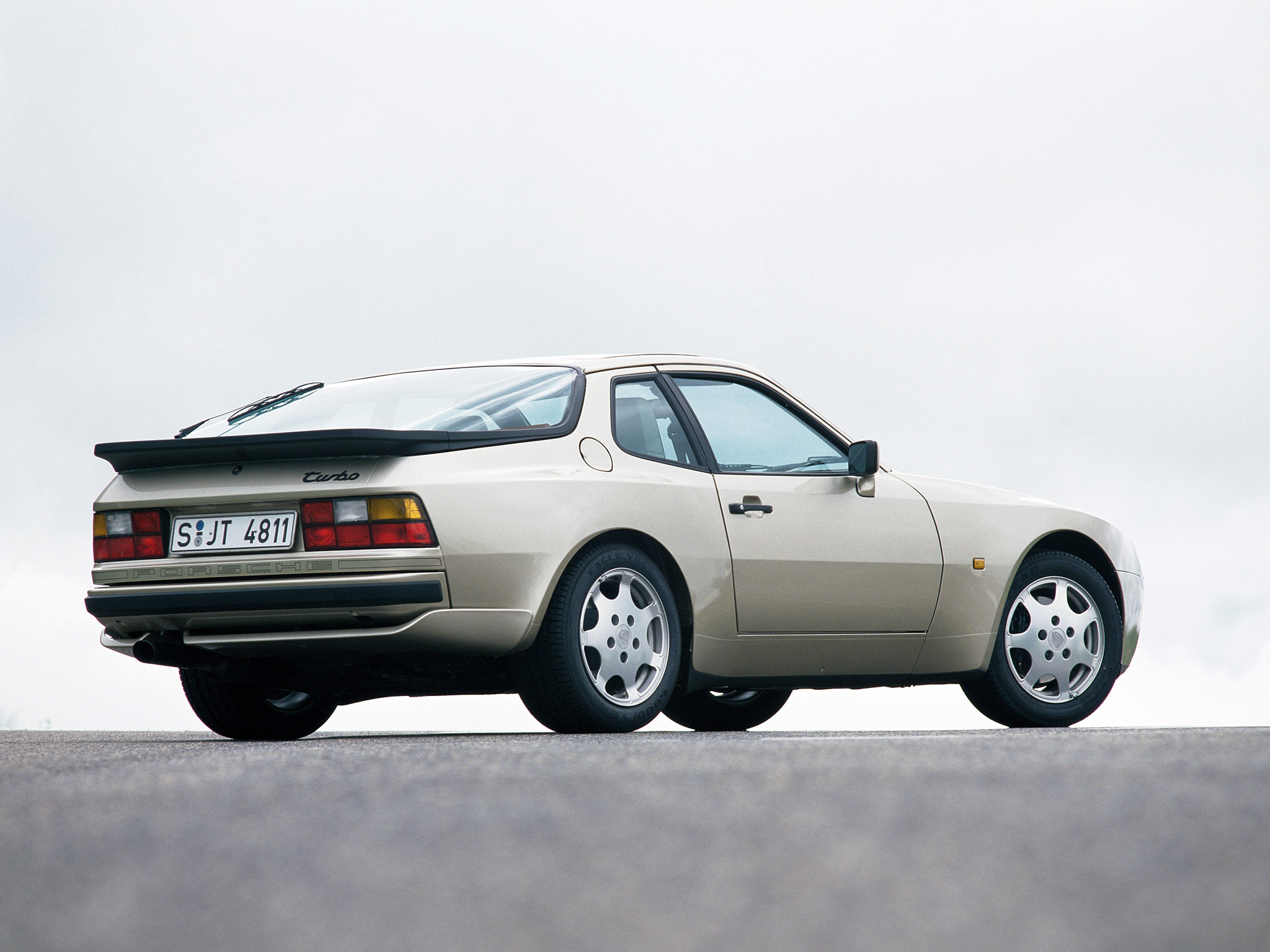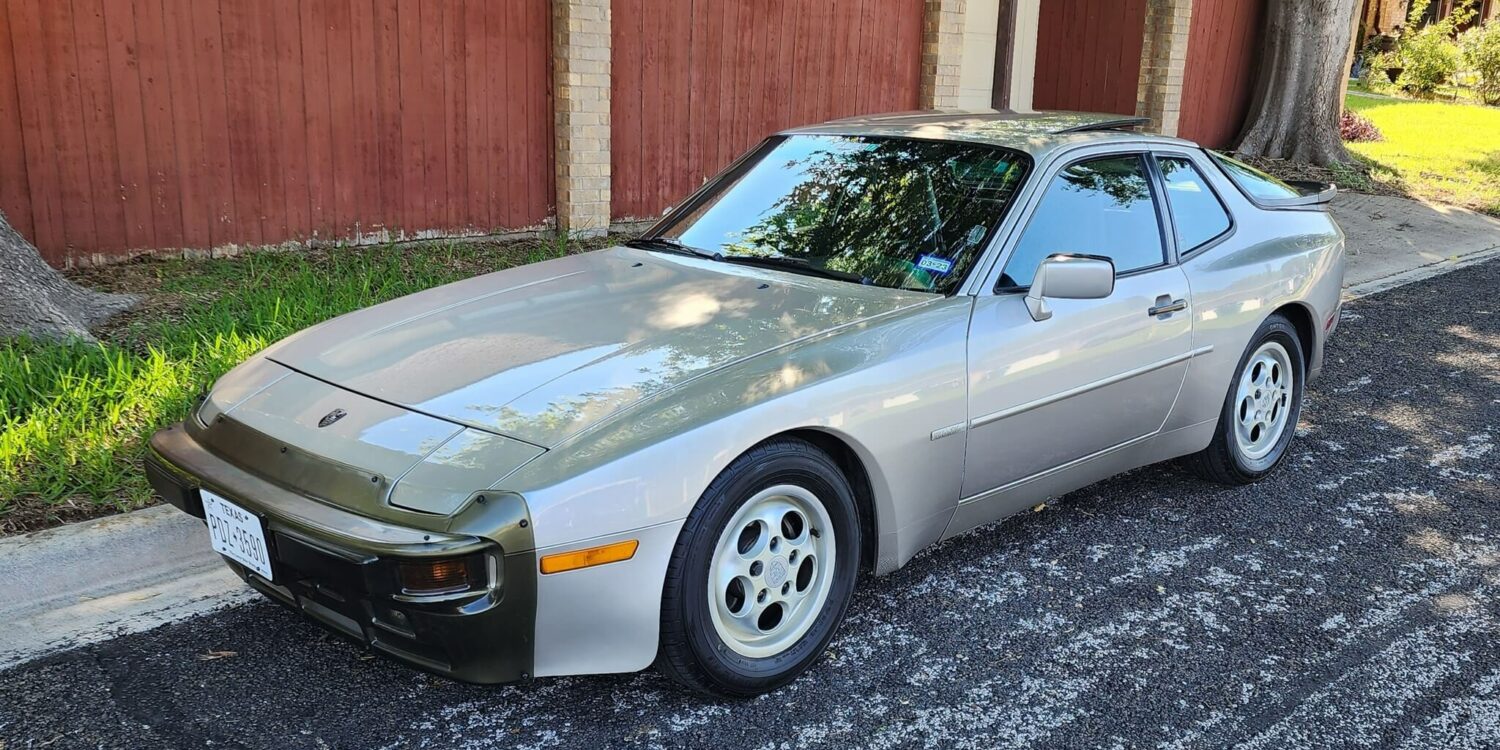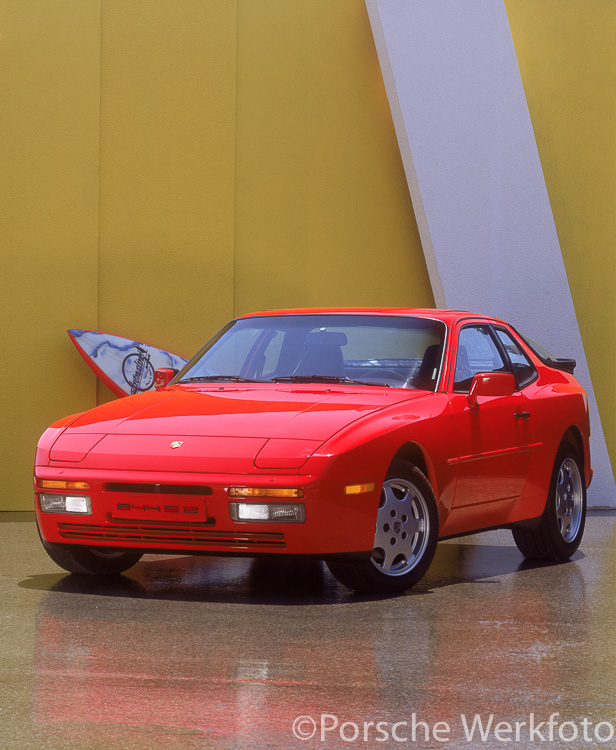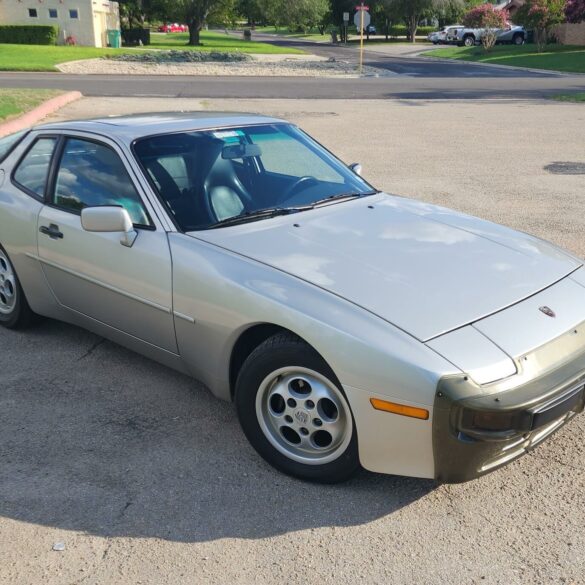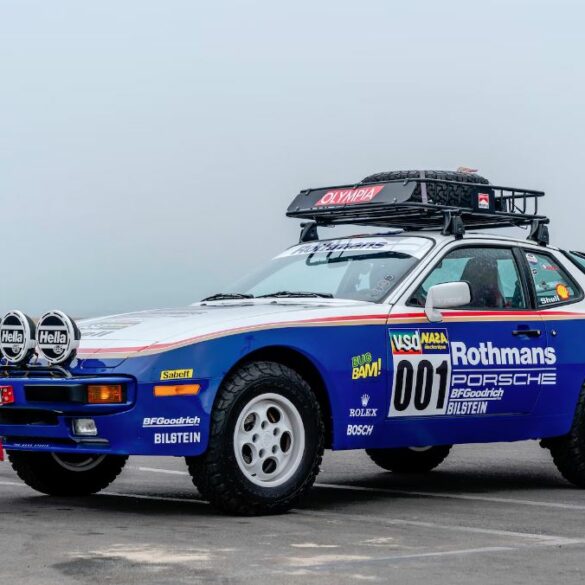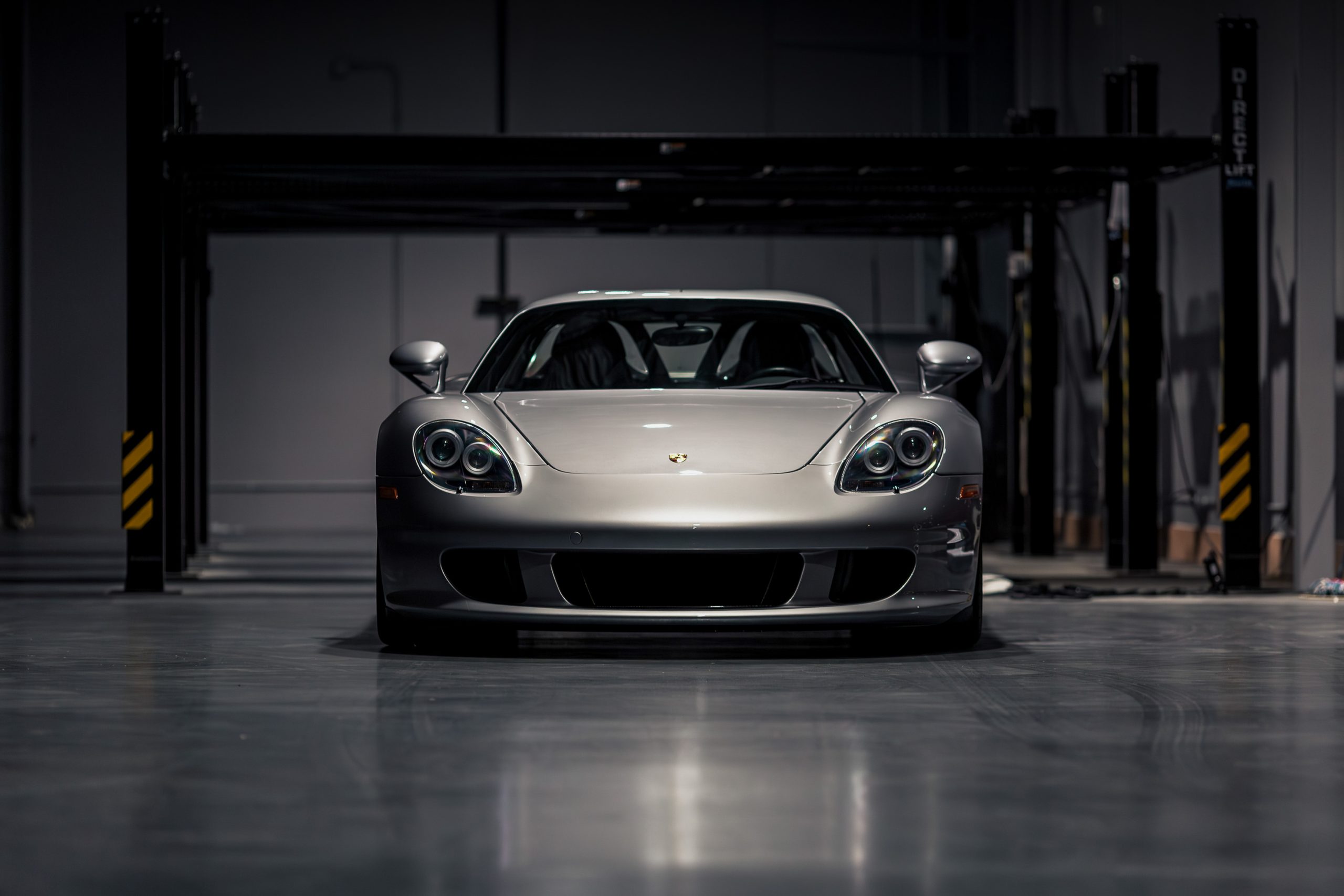Porsche 944 Buyer's Guide
Buying a Porsche 944? Our (Seriously In-Depth) Buyer’s Guide Covers Key Models, Potential Issues, Market Values, Expert Tips, What To Expect & MUCH More.
Introduced in the early 1980s as an evolution of the popular 924, the Porsche 944 quickly earned a reputation as one of the best-balanced, most engaging sports cars of its era. With its front-engine, rear-wheel-drive layout and a near-perfect 50:50 weight distribution, the 944 offered enthusiasts an accessible gateway into Porsche ownership without sacrificing handling or performance. Throughout its production run from 1982 to 1991, the 944 not only bolstered Porsche’s global sales figures but also proved itself as a dependable, stylish, and remarkably enjoyable driver's car—qualities that continue to attract collectors and enthusiasts alike.
Today, the Porsche 944 remains one of the smartest entry points into classic sports car ownership. Whether you're eyeing an early naturally aspirated variant, a more potent Turbo model, or the coveted 944 S2 and rare Turbo S editions, each offers a distinct driving experience and varying levels of collectibility. The 944’s robust mechanicals and relatively simple design make it accessible for DIY-minded owners, though selecting the right example is crucial to ensure long-term satisfaction and protect your investment.
In this comprehensive Porsche 944 Buyer's Guide, we'll explore key model differences, identify common issues to watch out for, analyze current market values, and provide expert insights to help you find your perfect 944. Whether you’re seeking a weekend cruiser, a track-day performer, or a future collectible, the 944 delivers timeless appeal combined with everyday usability. Let’s dive into what you can expect from ownership, and how to secure the ideal example of this iconic Porsche.
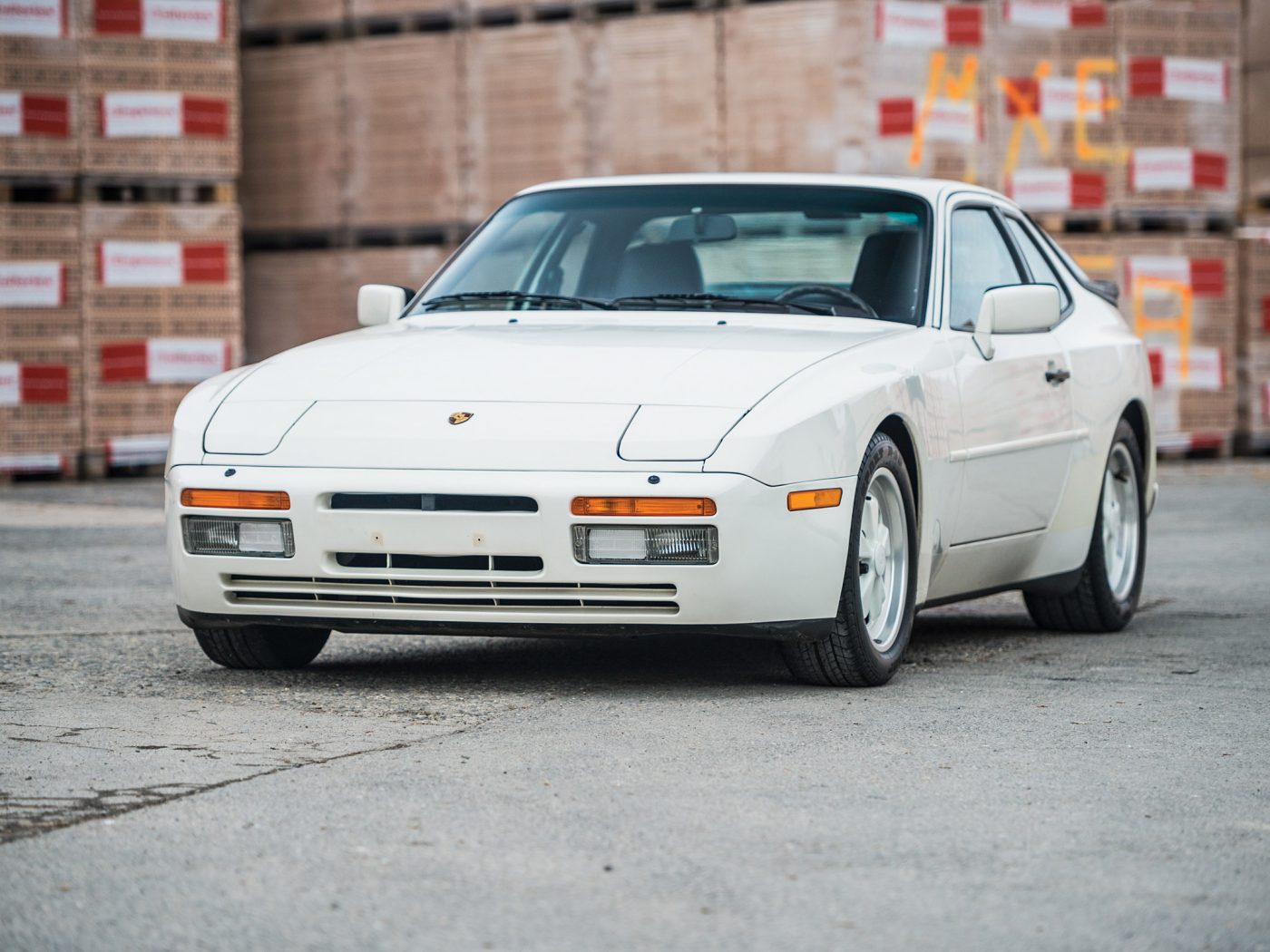
Why the Porsche 944 is a Unique Classic to Buy
The Porsche 944 stands uniquely positioned in the classic sports car market, delivering an unmatched combination of affordability, performance, practicality, and distinctive Porsche heritage. Launched during an era when Porsche sought to broaden its appeal, the 944 provided sports-car enthusiasts with exceptional balance, handling prowess, and driving enjoyment, all wrapped within a timelessly stylish, accessible package. Its front-engine, rear-wheel-drive layout, coupled with the signature transaxle configuration, granted the car near-perfect 50/50 weight distribution—something rarely matched even by modern sports cars.
What truly sets the Porsche 944 apart is its remarkable versatility and practicality as a classic. Unlike more fragile or temperamental vintage sports cars, the 944 was engineered for daily usability, making it an ideal choice for collectors who want a classic that doesn’t need to stay hidden away in a garage. Models like the naturally aspirated base variant are enjoyable cruisers, offering modest power combined with mechanical simplicity, while higher-spec versions like the 944 Turbo or the S2 provide genuinely thrilling performance even by today’s standards, ensuring there's a suitable variant for every type of enthusiast.
Another significant draw to the Porsche 944 is its approachable maintenance profile. Parts availability remains strong, supported by an enthusiastic community of owners and specialists dedicated to preserving the model. This accessible ownership experience contributes greatly to the car's unique appeal; it's a classic that invites involvement, learning, and hands-on care rather than demanding prohibitive maintenance budgets and constant specialist attention. While potential issues—like timing belt servicing, cooling system upkeep, or electrical quirks—are certainly factors to consider, they’re manageable when addressed proactively, further solidifying its appeal to first-time or seasoned classic car buyers alike.
Finally, from an investment standpoint, the Porsche 944 remains attractively priced, though appreciation has gradually increased over recent years. Unlike other Porsche models that have seen explosive valuation growth, such as air-cooled 911s, the 944 still offers room for buyers to enter the market at relatively attainable price points. With increasing recognition from enthusiasts and collectors worldwide, the 944 has genuine potential as an appreciating classic, particularly when purchasing well-maintained or rare variants like the Turbo, Turbo S, or the highly desirable S2. For buyers who value driving experience and practicality as much as future collectability, the Porsche 944 remains uniquely appealing and a rewarding classic to own.
Porsche 944 Variants - A Quick Primer for Potential Buyers On The Variants & Specials To Think About.
We already have ultimate guide to the Porsche 944 so we don't want to repeat everything here. Instead, we will give you a quick primer and summary about the main 944 variants, some of the core model year changes and we will talk about some special editions worth noting as you think about your potential purchase.
Key Variants & Differences
The Porsche 944 enjoyed a nearly decade-long production run from 1982 to 1991, and during this period, several key variants emerged, each offering a distinct driving experience and appeal to buyers today. Here’s an expert breakdown of the main variants and their significant differences.
Porsche 944 (Base Model, 1982-1989)
The original Porsche 944 launched with a 2.5-liter inline-four engine derived from half of Porsche’s 928 V8 engine, featuring an aluminum block and cylinder head. Initially producing around 143 hp, power gradually rose through minor revisions to approximately 163 hp by 1988. Naturally aspirated base models offer straightforward mechanicals, balanced performance, and reliable operation, making them ideal entry-level classics. Early cars came with simpler interiors and fewer options, while later models gained upgraded cabins, suspension refinements, and improved ergonomics, making later examples (post-1985) generally more desirable for regular use.
Porsche 944 Turbo (951, 1985-1991)
Introduced in late 1985 for the 1986 model year, the 944 Turbo—known internally as the Type 951—is perhaps the most famous variant, delivering dramatically increased performance. The Turbo employed a turbocharged version of the 2.5-liter engine, initially offering 217 hp (220 PS) and later increased to 247 hp (250 PS) in the sought-after Turbo S introduced in 1988 (standard in all Turbos from 1989 onward). The Turbo model included upgrades like larger brakes, stiffer suspension, aerodynamic improvements, and refined interiors. The 944 Turbo is highly prized for its significantly enhanced performance and tunability.
Porsche 944 S (1987-1988)
Positioned between the standard 944 and the Turbo, the 944 S featured a higher-revving 16-valve DOHC version of the naturally aspirated 2.5-liter engine, producing around 188 hp. It delivered smoother power delivery and improved responsiveness at higher RPMs, though the model was short-lived and often overlooked today compared to the more popular Turbo and S2 variants. However, for collectors who value rarity, the 944 S remains a compelling option.
Porsche 944 S2 (1989-1991)
Arguably the sweet spot of the 944 range, the 944 S2 introduced Porsche’s larger 3.0-liter, naturally aspirated, 16-valve inline-four—the largest production four-cylinder engine of its time—developing a healthy 208 hp. Alongside the upgraded powertrain, the S2 inherited many Turbo enhancements, such as suspension components and larger brakes, but without the complexities of forced induction. Additionally, the 944 S2 Cabriolet debuted in 1989, bringing a stylish open-top variant into the lineup, appealing to those seeking a more relaxed, grand-touring experience.
Porsche 944 Turbo S (1988)
Briefly offered in 1988, the Turbo S was a limited-production special, initially built to homologate performance upgrades for motorsport. Delivering 247 hp and incorporating uprated suspension, larger brakes from the 928 S4, limited-slip differential, and unique interior touches, it represents the pinnacle of 944 performance. From 1989 onwards, all Turbo models were built to Turbo S specification, though the original limited-production 1988 Turbo S retains special desirability among collectors.
Each variant of the Porsche 944 offers distinct characteristics, from practical and affordable naturally aspirated base models to the sought-after performance and rarity of the Turbo S. Understanding these differences is critical for prospective buyers, enabling them to select the model best suited to their tastes, budgets, and long-term goals in classic car ownership.
Model Year Changes (1982-1991)
Understanding Porsche 944 model-year changes is crucial for prospective buyers, as incremental refinements throughout its production run significantly impacted the driving experience, desirability, and long-term value. Here's an expert breakdown of the most important year-to-year evolutions:
1982–1985: Early Porsche 944
The Porsche 944 debuted in 1982, offering a substantial upgrade from the 924 with its wider body, flared wheel arches, and the 2.5-liter, 8-valve inline-four producing approximately 143 hp (150 PS). Initially, cars had a simpler, less refined interior, manual steering, and were relatively basic in amenities.
In mid-1985 (1985.5 models), Porsche introduced significant updates: a refreshed interior with a modernized dashboard design, improved ventilation system, ergonomic control layouts, upgraded seats, and revised suspension tuning. These 1985.5 models are notably more comfortable and refined compared to earlier cars, making them more attractive for regular use today.
1986: Introduction of the 944 Turbo (951)
The most significant model-year update occurred in 1986 with the introduction of the 944 Turbo (951). This high-performance variant received a turbocharged 2.5-liter engine producing around 217 hp (220 PS), larger brakes, stiffer suspension, power steering as standard, upgraded transmission, and distinctive aerodynamic bodywork including integrated front bumper and rear diffuser. For non-turbo models, improvements included revised suspension tuning and standardization of power steering and alloy wheels.
1987–1988: Porsche 944 S and ABS Introduction
In 1987, Porsche added the 944 S, featuring a naturally aspirated, dual overhead-cam 16-valve 2.5-liter engine with 188 hp, offering smoother power delivery and improved high-rev performance. Notably, this period also introduced ABS as an option, greatly improving safety and braking performance. Model-year 1987 cars also received strengthened suspension components, updated engine mounts, and additional sound insulation for enhanced refinement.
In 1988, Porsche produced a limited-run Turbo S variant, boasting 247 hp (250 PS), upgraded suspension, larger brakes borrowed from the Porsche 928 S4, a limited-slip differential, unique interior features, and special paint options. Post-1988 Turbo cars all received these enhancements, raising their desirability today.
1989: Introduction of the 944 S2 and Cabriolet
1989 marked another significant shift, replacing the short-lived 944 S with the more powerful 944 S2, featuring a new 3.0-liter 16-valve engine—the largest displacement four-cylinder at the time—developing 208 hp. It also adopted Turbo-derived suspension and braking components, blending performance and usability. Additionally, Porsche launched the 944 S2 Cabriolet, a stylish and refined convertible version offering open-air driving in a more luxurious package. Turbo models continued as standard Turbo S specification from this year forward.
1990–1991: Final Updates and End of Production
In its final years (1990–1991), Porsche continued incremental improvements to build quality, interior refinement, and reliability. The S2 Cabriolet received further structural enhancements, reducing chassis flex. Additional refinements included improved engine mapping, better corrosion protection, updated air conditioning systems, and enhanced interior materials. Production concluded in 1991, making late-production 944 models particularly desirable for collectors due to their refinement and rarity.
Each model-year update improved the Porsche 944's appeal, either in performance, usability, or comfort.

Porsche 944 Market Value & Pricing
Market values for the Porsche 944 have steadily risen over recent years, reflecting increasing recognition of its merits as an affordable yet genuine classic sports car. Early base-model 944s (1982–1985) typically represent the most accessible entry point, with good, driver-quality examples generally available in the $7,500 to $12,000 range. Later, improved models (1985.5–1988) command slightly higher prices, averaging around $10,000 to $15,000 for solid, well-maintained cars. More desirable variants, like the 944 Turbo, consistently fetch premiums; excellent examples routinely sell for between $20,000 and $35,000, with the rarer Turbo S models approaching or even exceeding $40,000 in pristine condition. At the higher end, the 944 S2—especially the Cabriolet—has become notably desirable among collectors, often priced in the $20,000 to $35,000 range for well-cared-for examples. Exceptional cars with meticulous histories and low mileage can even exceed these estimates. Across all variants, careful maintenance history, original condition, mileage, and specification significantly influence values. While prices continue to trend upward, the 944 remains an attractive value proposition compared to other classic Porsches, making now an excellent time to buy before values climb further.
What Are 944s Worth?
Here’s a detailed breakdown of Porsche 944 values by condition and model type, from rough project cars to concours-quality collector pieces. The 944 has grown in popularity and value in recent years, especially as the vintage Porsche market matures and enthusiasts turn to transaxle cars for their balance, performance, and affordability.
Project Cars & Non-Runners
$2,000 – $6,000
This tier includes 944s that are rough, neglected, or not running. You’ll often find them with blown head gaskets, timing belt failures, electrical problems, or rust. Interiors are usually trashed, paint is faded or peeling, and mileage is high. Restoration costs can easily exceed the car’s value unless you’re doing the work yourself—and even then, parts and labor can quickly add up. Typical models in this range include early base 944s (1983–1985) or cars with salvage titles or missing records.
Running Drivers With Needs
$6,000 – $12,000
These are running and driving cars, but with notable cosmetic flaws, tired interiors, deferred maintenance, or minor mechanical issues. They’re often high-mileage but usable, and with time and effort, can be turned into respectable weekend cars. Still, buyers should budget for things like suspension refreshes, timing belts, and clutch work. Typical models in this range include early 944s and higher-mileage 944 S and 944 S2 models. This is the sweet spot for enthusiasts on a budget.
Solid Driver-Quality Cars
$12,000 – $20,000
This price range includes well-maintained, rust-free 944s with documented service history, clean interiors, and strong mechanicals. They may not be perfect or entirely original, but they’ve been cared for and are ready to drive and enjoy. Cars in this category are often serviced regularly and may include some tasteful upgrades or cosmetic restoration work. Typical models in this range include 944 S2 coupes (1989–1991), 944 Turbo with higher mileage and later-model base 944s with clean records.
Excellent, Mostly Original Examples
$20,000 – $35,000
Here you’ll find well-preserved 944s with low to moderate miles, strong originality, and full service records. These cars have likely had recent major service (timing belts, water pump, clutch), clean paintwork, fresh interiors, and are becoming increasingly sought after by collectors. Turbo models in this range can be fast, fun, and still reliable when maintained correctly. Typical models in this range include low-mileage 944 S2s, 944 Turbo (951) in clean, stock condition and Late 944 NA cars in pristine shape.
Investment-Grade & Show-Quality
$35,000 – $60,000+
Reserved for ultra-clean, low-mileage, completely original or perfectly restored examples, especially of the 944 Turbo and Turbo S models. These cars are desirable not only for their performance but for their rarity and historical significance. Special colors, rare factory options, and impeccable provenance all push values upward. Typical models in this range include 944 Turbo S (1988) in top condition, low-mileage 944 Turbo (1986–1989) with rare options and concours-quality base 944 or S2s.
Factors That Affect Value
The Porsche 944 has transitioned from overlooked transaxle oddity to sought-after classic over the past decade. As the market has matured, values have become more stratified, and specific factors now play a significant role in determining what a 944 is worth. Here's a breakdown of the key elements that influence pricing, whether you’re buying, selling, or just watching the market.
1. Model and Variant
Not all 944s are created equal. The variant is the single biggest driver of value. Base early cars (1983–1985) are the most affordable, while later, more powerful models like the 944 S2 (3.0L DOHC) and especially the 944 Turbo (951) command significantly higher prices. The 1988 Turbo S, with its upgraded suspension, larger turbocharger, and limited-slip differential, sits at the top of the performance and value ladder. Convertibles, while rare and appealing to some, generally lag behind coupes in collector desirability.
2. Condition
As with most classics, condition is king. A 944 with original paint, clean interior, and no rust or body damage is worth far more than a tired, high-mileage example. Mechanical condition is also critical—these cars require timing belt services, clutch replacements, and suspension refreshes at regular intervals. Buyers will pay a premium for a car that’s had recent major service and doesn’t need immediate work.
3. Mileage
Lower mileage 944s typically command higher prices, especially if the mileage is well-documented. That said, a high-mileage but well-maintained car can be a better value than a low-mileage car with deferred maintenance. Enthusiasts often favor cars that have been driven and cared for over time, rather than cars that have sat unused for years.
4. Service History and Documentation
Buyers increasingly value a stack of service records, original manuals, window stickers, and tool kits. Documentation adds trust and provenance, particularly with high-value Turbo or S2 models. A well-documented 944 with evidence of careful ownership often sells faster—and for more money—than one with an unknown past.
5. Color and Options
Originality matters, and so do aesthetics. Cars in rare or desirable factory colors (like Guards Red, Stone Grey Metallic, or Zermatt Silver) tend to sell faster and for more. Similarly, factory options like sport seats, limited-slip differentials, Fuchs wheels, or upgraded audio systems can add meaningful value, especially on higher-end models.
6. Modifications (Good and Bad)
Light, tasteful upgrades—like performance suspension, period-correct wheels, or exhaust improvements—can add appeal to some buyers, particularly if they’re reversible. However, heavily modified 944s tend to be worth less, especially if originality is compromised or the work was DIY. Purists and collectors typically pay more for stock or near-stock cars.
7. Market Trends and Enthusiast Attention
The broader collector market plays a big role. As transaxle Porsches gain recognition, especially among younger buyers and those priced out of the air-cooled 911 market, 944 values have steadily risen. When notable auction results or media attention spotlight specific models (like the 944 Turbo S), it can cause a short-term surge in demand and prices.
8. Rarity and Production Numbers
Later 944s, like the 1989–1991 S2 and Turbo, were produced in smaller numbers, making clean examples harder to find. The 1988 Turbo S is particularly rare, with only around 1,900 made for North America, making it the most collectible production 944. Rarity, when combined with good condition and originality, always strengthens value.
The Porsche 944’s value is shaped by a combination of specification, condition, provenance, and market timing. While prices have risen, there are still great opportunities.
Investment Potential
The Porsche 944 has evolved from being the underappreciated sibling of the 911 to one of the most interesting and accessible Porsche collectibles of the modern era. While it may not have the air-cooled mystique or soaring values of its rear-engined counterparts, the 944 offers genuine Porsche DNA, excellent handling, and rising market recognition—all of which contribute to strong investment potential, especially for specific variants.
A Rising Star in the Transaxle Porsche Movement
For years, the 944 lived in the shadow of the 911, often overlooked for its front-engine layout and perceived ties to Volkswagen. But as the collector market matures—and as 911 prices have moved out of reach for many enthusiasts—interest in Porsche’s transaxle cars (924, 944, 968, and 928) has surged. The 944, with its balance of affordability, usability, and engaging driving dynamics, has become a key entry point for new collectors and long-time enthusiasts alike.
As demand grows for vintage sports cars that are analog, fun to drive, and relatively easy to maintain, the 944 fits the bill. Values have already been on the rise over the past five years, and the curve is still trending upward—especially for high-quality and rare examples.
Which 944 Models Have the Most Upside?
Not all 944s will appreciate equally, and the best investment potential lies in specific models, trims, and condition tiers:
1988 Porsche 944 Turbo S: With its upgraded suspension, more powerful turbo engine (250 hp), and limited-slip differential, the Turbo S is the holy grail of the 944 lineup. Clean, low-mileage examples are already commanding $40,000–$60,000, and prices are expected to continue climbing as collectors seek the best of the best.
1986–1989 944 Turbo (951): The standard Turbo offers excellent performance and driver engagement. These cars remain undervalued compared to their performance and rarity. Pristine, unmodified examples with full documentation are increasingly seen as investment-grade.
1989–1991 944 S2 (Coupe and Convertible): The 3.0L DOHC engine makes these some of the most enjoyable naturally aspirated transaxle Porsches. Low-production numbers, especially of convertibles, and strong performance make the S2 a solid appreciation candidate—particularly in rare colors or with low mileage.
Early Base 944 (1983–1985.5): These are still relatively affordable and represent entry-level investment potential. Look for clean, rust-free survivors with low miles and original features. Values are modest now but expected to rise as top-tier examples become scarce.
What’s Driving the Market?
Several factors are pushing the 944 up the classic car value chain:
Shift toward usable classics: Buyers want vintage cars they can actually drive, and the 944’s comfort, practicality, and reliability make it far more approachable than many other classics.
Generational appeal: Enthusiasts who grew up in the '80s and '90s are entering their prime collecting years and are chasing the cars they idolized—cars like the 944.
Rarity of quality examples: Many 944s were used hard and left unloved for years. Well-preserved, low-mileage cars with original paint and clean interiors are becoming scarce—and values are rising as a result.
Final Thoughts: A Smart Buy for Enthusiasts and Collectors
The Porsche 944 is no longer the “cheap Porsche” it once was. It’s matured into a legitimate classic with real driving enjoyment and increasing respect in the collector world. While you shouldn’t expect 911-level returns, the 944 offers a compelling blend of appreciation potential and driving fun, especially if you buy the right car.
For buyers looking to invest, focus on condition, documentation, and desirable specs. Unmolested Turbos, Turbo S models, and S2s in rare colors or with factory options will lead the market in years to come. For those who love to drive, the bonus is that you get to enjoy one of the most well-balanced sports cars of its era while it quietly climbs in value.
Recent Porsche 944 Values & Market Sales Trends
Below, our friends at Classic.com chart recent sales and trends in the Porsche 944 market.
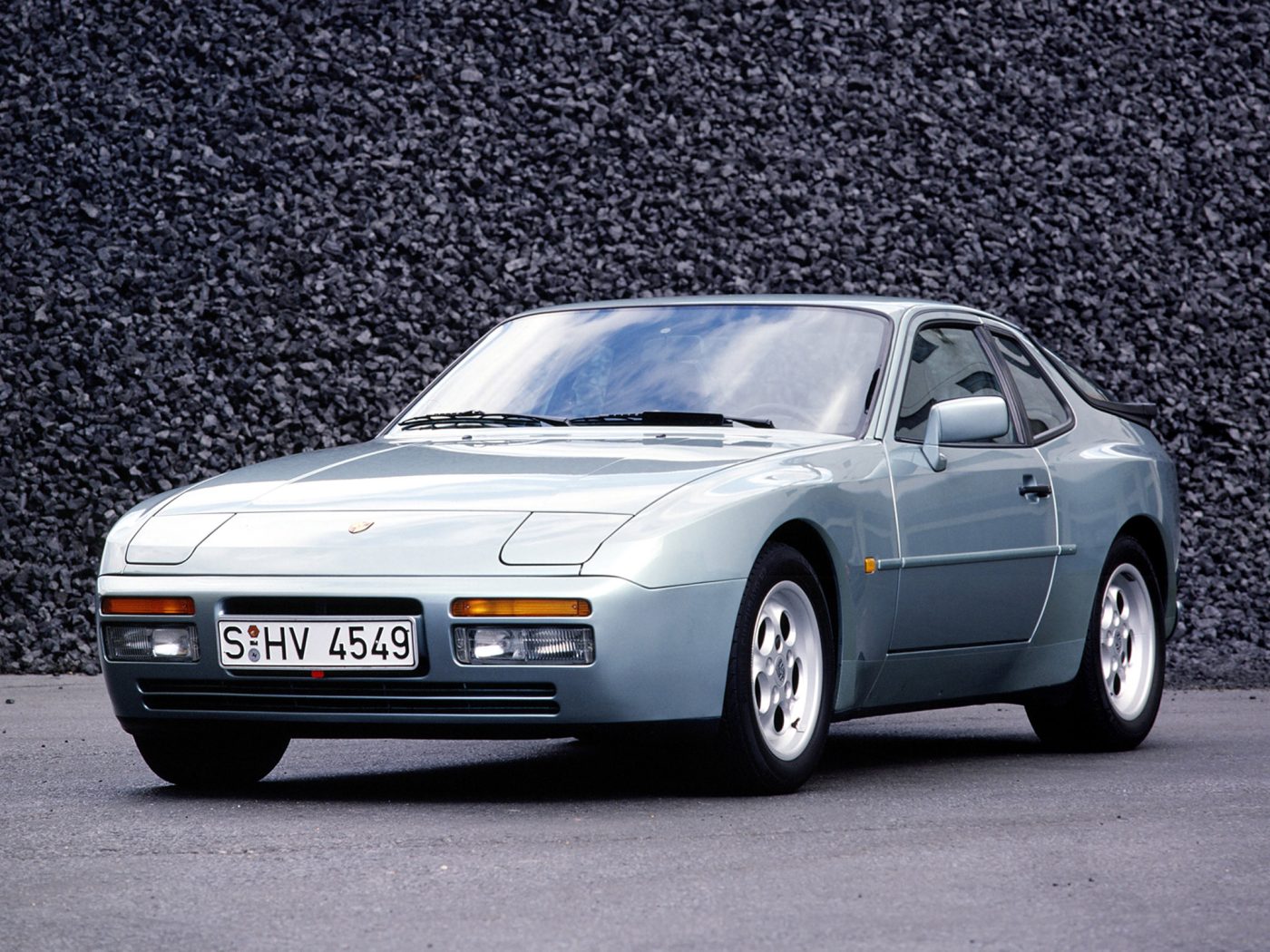
Porsche 944 Driving Experience & What to Expect
What They Said at The Time
When the Porsche 944 debuted in 1982, it was met with widespread acclaim from the automotive press, praised as a major leap forward from the 924 it replaced. Journalists quickly recognized that Porsche had refined the transaxle formula, addressing the criticisms of the earlier model by delivering a car that felt distinctly more "Porsche" in both design and performance. With its flared fenders, near-perfect weight distribution, and a new Porsche-developed 2.5L inline-four, the 944 was seen as a sports car that could stand on its own merits.
Car and Driver, in its early review, said the 944 was
“the best-balanced car Porsche has ever built... surefooted handling and steering precision that borders on telepathy.”
Reviewers were especially impressed with how neutral the chassis felt through corners—an experience that was rare at the time outside of high-end sports cars. Despite having relatively modest horsepower in its early years, the 944's chassis was so well sorted that it often overshadowed more powerful rivals on twisty roads.
Road & Track echoed the sentiment, calling the 944
“a driver’s car in the purest sense... a remarkable blend of performance, practicality, and comfort.”
The magazine pointed out that the 944 wasn’t just fast—it was well-mannered and predictable, making it accessible to novice drivers and rewarding for experienced ones. They especially liked the refinement of the 944's new engine, which Porsche designed in-house, describing it as “silky smooth and eager to rev.”
Even European outlets lauded the 944’s poise and sophistication. UK-based Autocar described it as “the sports car you can drive every day, without compromise,” and emphasized its surprisingly compliant ride and practical hatchback layout. For many, the 944 was the ideal sports car of its era—not just for its sharp driving experience, but for its usability and approachability.
The critical reception helped solidify the 944's status as more than just an entry-level Porsche. At the time, it was viewed as one of the most complete and refined sports cars on the market, capable of thrilling on a backroad while also serving as a comfortable and reliable daily driver. That duality is a big part of why enthusiasts—and the market—have returned to the 944 in recent years with a renewed sense of respect.
What to Expect Today
Driving a Porsche 944 is a deeply rewarding, analog experience—an embodiment of everything that made 1980s and early '90s sports cars so engaging. It's not about jaw-dropping horsepower or wild straight-line speed; instead, the 944 delivers a balance, composure, and driving feel that few cars of its era (or even today) can match. Whether you’re behind the wheel of a base model, a 944 S2, or a Turbo (951), the 944 is all about confidence-inspiring precision.
Thanks to its front-engine, rear transaxle layout, the 944 boasts near-perfect 50:50 weight distribution. That makes it feel incredibly planted in corners, with neutral handling characteristics and predictable behavior even at the limit. The steering is manual or lightly assisted, depending on the model, and gives excellent feedback, letting you feel exactly what the car is doing. The suspension is firm but not punishing, and the chassis is communicative without being nervous. It's a car that teaches you to be a better driver—encouraging momentum driving, clean inputs, and smooth shifts.
In terms of performance, expectations should be aligned with the era and model. The early NA cars (143–150 hp) are fun but not fast by modern standards—0–60 mph is in the 8-9 second range. The 944 S (with a 16-valve head) and the 944 S2 (with a 3.0L DOHC engine and 208 hp) feel significantly quicker and more responsive. The 944 Turbo (951) is the star performer of the lineup, with 220–250 hp depending on the year. It brings genuinely quick acceleration and strong midrange punch, especially once the turbo spools up. But across all models, what stands out isn’t brute power—it's the refined road manners and incredible poise.
As a daily driver, the 944 surprises many with its practicality. The hatchback design offers real cargo space, and the cabin, while dated by modern standards, is ergonomic and comfortable for long drives. Visibility is excellent, controls are well laid out, and the car feels composed in traffic or on the highway. However, some models lack air conditioning or power amenities, and parts of the interior (like dash plastics) can feel fragile after decades. Most enthusiasts use their 944s as weekend cars or vintage commuters, though many have been happily daily-driven with proper maintenance.
For a potential buyer, the 944 offers a compelling mix of usability, character, and classic Porsche engineering. It's one of the best-handling cars of its era, and it still holds up today on backroads, in traffic, or on the track. Values are climbing, but they remain reasonable compared to air-cooled 911s, and parts availability is still good for most variants. If you're looking for a car that’s fun to drive, rewarding to own, and steeped in genuine Porsche DNA, the 944 absolutely deserves your consideration. It’s not just a great vintage Porsche—it’s one of the most satisfying classic sports cars you can buy.
Getting Real - Costs to Own & Maintenance
The Porsche 944 has earned a reputation as one of the most affordable ways to get into classic Porsche ownership. But while it’s far more budget-friendly than a 911, it’s still a precision-engineered German sports car—and that means it comes with maintenance expectations that shouldn’t be overlooked. The good news is that the 944 is generally reliable and parts remain accessible, especially for base and naturally aspirated models. With smart ownership and regular upkeep, a 944 can deliver a rewarding and manageable ownership experience.
Ownership Costs & Maintenance: What to Expect
At its core, the 944 is a solid and well-built machine, but it demands proactive maintenance to stay that way. The most important routine service is the timing belt and water pump, which need to be replaced every 30,000–40,000 miles or 5 years. Neglecting this job, especially on interference engines like the 944S, S2, or Turbo, can result in catastrophic engine damage. A full belt service with rollers and water pump typically costs $1,200–$1,800 at a reputable shop.
Other common maintenance includes clutch replacements ($1,500–$2,500), suspension refreshes (bushings, shocks, ball joints), and fuel system work on cars that have been sitting. Regular items like oil changes, brake jobs, and fluids are fairly affordable—usually $100–$400 depending on labor and quality of parts. If you’re buying a car that’s been neglected, budget for an initial round of catch-up maintenance that could range from $2,000–$5,000, especially if you're chasing down electrical issues or restoring cosmetic bits.
Overall, if you start with a good car and stay on top of maintenance, annual ownership costs typically fall between $1,000 and $2,500, depending on how much you drive and how much work you do yourself.
Parts Availability & Pricing
Parts availability for the Porsche 944 is generally excellent, especially for later models and common wear items. Mechanical components, including brakes, engine parts, and suspension, are still produced or available through Porsche Classic and aftermarket suppliers. Prices are reasonable compared to other classic Porsches, and many items are shared across models, helping to keep costs down.
Where things can get more expensive is in the interior and trim department. Dashboards, door panels, and center consoles can be hard to find in good condition, especially in rare colors. Early cars (pre-1985.5) have unique interiors that are becoming more difficult to restore. Body parts for Turbo and S2 models, like spoilers, valences, or specific bumpers, also tend to be pricey when damaged.
Fortunately, the strong 944 enthusiast community, online forums, and parts suppliers make tracking down components easier than with many other vintage European cars.
Insurance Costs for a Porsche 944
Insurance is one of the most affordable aspects of 944 ownership. If the car is insured as a collector or weekend vehicle, annual premiums usually range from $300 to $700, depending on your location, driving history, and the car’s agreed value. Companies like Hagerty, Grundy, and American Collectors Insurance offer favorable rates for limited-use vehicles.
If you plan to daily drive your 944, a standard full coverage policy through a traditional insurer will typically cost $900–$1,500 annually, with younger drivers or urban zip codes on the higher end. Still, even at those rates, the 944 remains a relatively cheap car to insure for the performance it offers.
Final Thoughts
Owning a Porsche 944 is one of the best-kept secrets in classic car enthusiasm. It offers a real Porsche driving experience, standout design, and a growing collector following—without the sky-high running costs of its more famous rear-engined siblings. As long as you respect its maintenance needs, especially the timing belt and cooling system, the 944 rewards its owners with reliability, performance, and long-term value. Buy the best one you can afford, stick to a regular service schedule, and you’ll be rewarded with one of the most enjoyable—and increasingly appreciated—classic sports cars on the road.
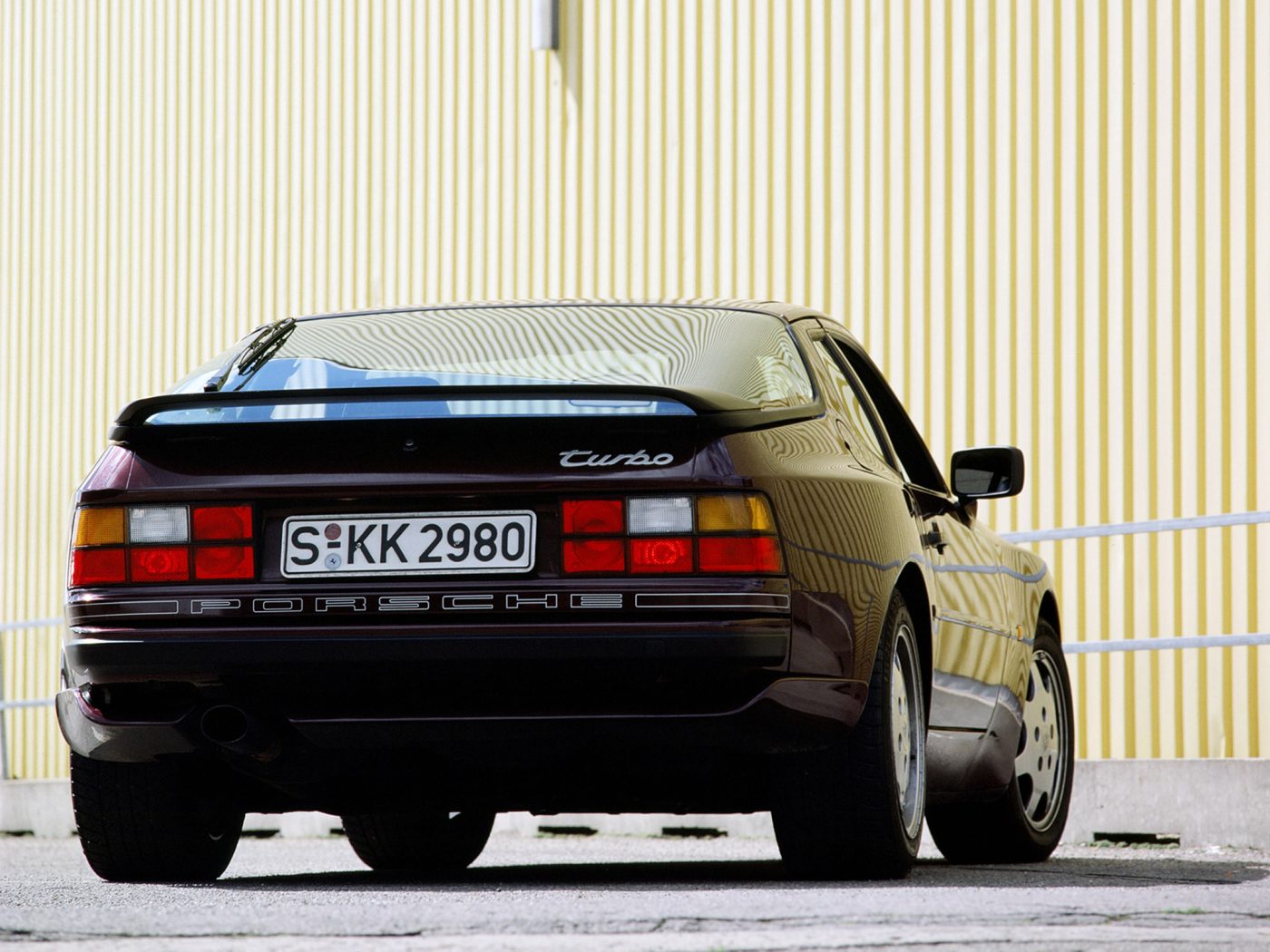
Other Key Buying Considerations
Ensuring Performance, Authenticity, and Long-Term Enjoyment
While knowing the common mechanical issues is crucial when shopping for a Porsche 944, there are several other important factors that can dramatically affect your ownership experience, cost, and long-term enjoyment. From documentation and originality to model choice and parts availability, these considerations will help you make a smarter, more satisfying purchase.
Choose the Right 944 Variant for Your Needs
The 944 lineup includes several models—base (NA), S, S2, Turbo (951), and Turbo S—each with a different driving character, maintenance profile, and price point. The base 944 is simpler and less costly to run, while the S2 and Turbo offer significantly more performance but with added complexity and higher parts and service costs. Figure out whether you want a weekend cruiser, a vintage daily, or a potential collectible, and buy accordingly.
Prioritize Documentation & Service Records
A 944 with thorough maintenance records is worth significantly more than one with a “clean” appearance but no paper trail. These cars are now old enough that past ownership and care matter more than odometer readings. Documentation of key services—timing belts, clutch, suspension work—gives you confidence and protects your investment.
Originality vs. Modification
Many 944s have been modified over the years, from suspension setups to engine swaps or aftermarket interiors. Some upgrades, like performance suspension or tasteful wheels, can be a plus. But heavy modifications often hurt value and complicate reliability. Stock or lightly modified cars with factory parts tend to be more desirable, especially to collectors.
Rust & Body Condition Matter More Than Mileage
The 944 is generally well-built and rust-resistant, but not immune. Areas to check include battery tray, wheel wells, door sills, underbody, and rear hatch area. A car with a solid body and cosmetic patina is often a better buy than a glossy respray hiding rust or accident damage. Structural rust is a dealbreaker.
Be Realistic About Restoration Costs
Refinishing a dashboard, retrimming seats, replacing suspension bushings, and chasing electrical gremlins can add up—quickly. Even if the purchase price is low, a tired 944 can require $5,000–$10,000 to bring up to standard. It’s often cheaper to buy a better car up front than to rescue a rough one.
Parts Availability & Shop Support
Parts are still available for most 944 models, especially through Porsche Classic and the enthusiast aftermarket. However, early interiors and Turbo-specific parts can be expensive or hard to find. It's also smart to know whether you have a local Porsche specialist or transaxle-experienced mechanic nearby, especially for Turbo and S2 owners who don’t plan to DIY.
Market Trends & Resale
Interest in 944s is growing, particularly for clean, unmolested examples and rarer models like the Turbo S and S2. Values are climbing, but these cars still represent good value—if you buy well. Think of resale not just in terms of price, but desirability: colors, options, and documentation will help your car stand out when it’s time to sell.
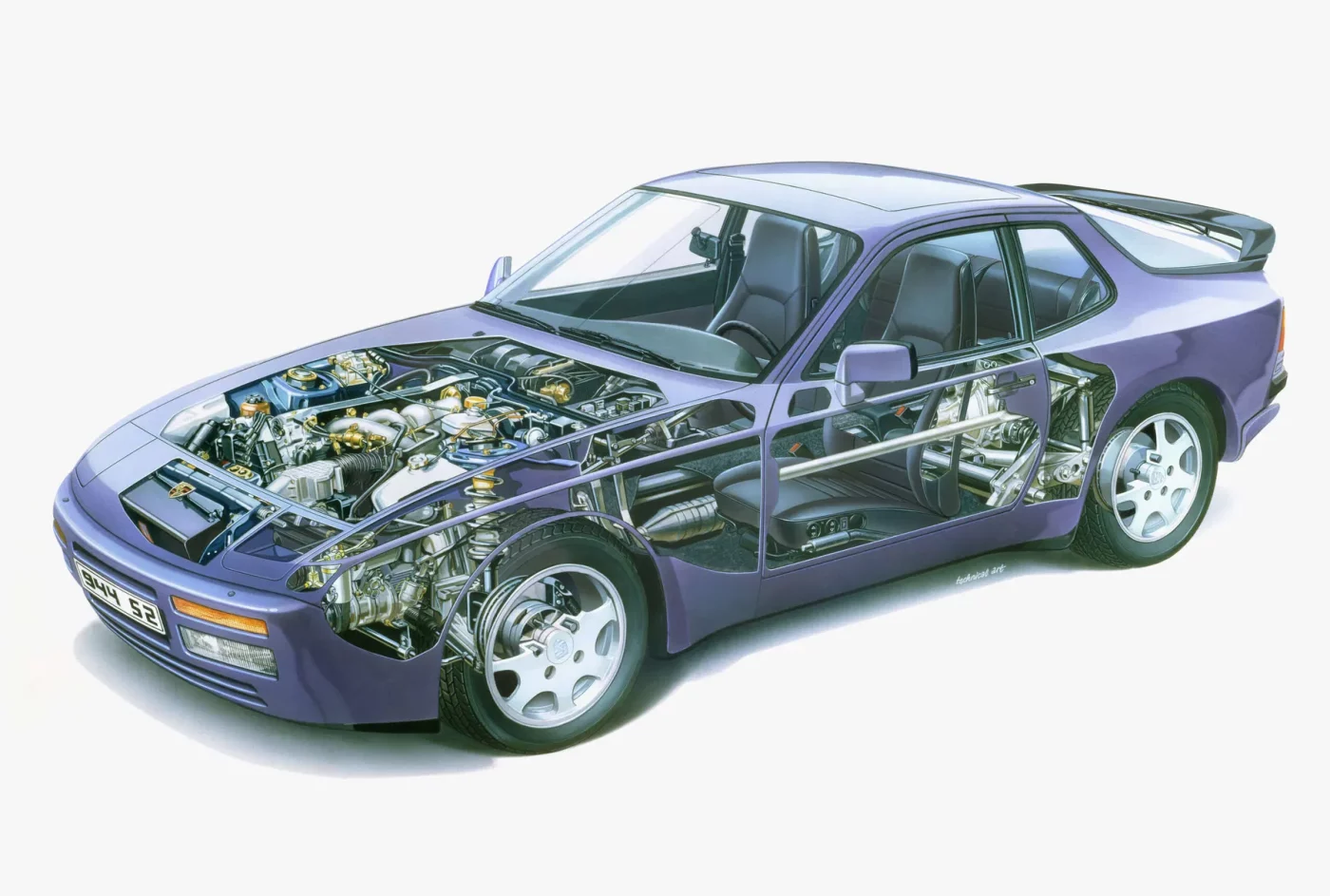
Common Porsche 944 Problems
What Buyers Should Know
The Porsche 944 is well-regarded for its balanced handling, durability, and engineering quality—but it’s still a 30- to 40-year-old German sports car. While it's more affordable to maintain than many classic Porsches, a poorly maintained or neglected 944 can quickly become a money pit. If you’re in the market for one, knowing the common issues to watch for can help you avoid costly surprises and make a smart buy.
(see our full article on common Porsche 944 problems here).
1. Timing Belt & Water Pump Neglect
One of the most important—and expensive—maintenance items is the timing belt. On interference-engine models (944S, S2, and Turbo), failure can cause catastrophic engine damage. Even base models risk engine failure if the belt breaks. The timing belt and water pump should be replaced every 30,000–40,000 miles or every 5 years, along with the balance shaft belts and rollers. Confirm a recent belt service with documentation. If there's no record, budget at least $1,200–$1,800 to have it done immediately.
2. Clutch Wear
The 944’s clutch, especially on Turbos, is known to wear over time—particularly on cars driven hard or with higher mileage. Replacement is labor-intensive due to the transaxle layout and can cost $1,500–$2,500. Look for a high clutch pedal, slipping under load, or difficulty shifting can signal a worn clutch.
3. Oil Leaks & Front Engine Seals
The 944 can suffer from oil leaks at the cam tower, balance shaft seals, and front crankshaft seals. These often appear as slow leaks or oil drips near the timing belt cover, which can also contaminate the belt. Check for oil residue under the front of the engine or signs of a messy timing belt area. If you’re unsure, have a shop inspect the seals.
4. Suspension & Steering Wear
Many 944s have worn-out suspension components after decades on the road. Common issues include bad bushings, leaking struts, worn ball joints, and steering rack leaks. Look for clunks over bumps, vague steering, or uneven tire wear can all point to tired suspension. A proper refresh can cost $1,500 or more, depending on the parts replaced.
5. Electrical Gremlins
Aging wiring, grounds, and fuse panels can lead to non-functioning gauges, power windows, sunroof issues, or intermittent lighting problems. These can be tricky to trace and are common in cars with previous owner modifications. Test all lights, windows, sunroof, mirrors, and gauges. Look under the dash for hacked wiring or signs of moisture.
6. Interior Deterioration
Dash cracks, faded upholstery, sagging headliners, and brittle plastics are common, especially in sun-exposed cars. Early interiors (pre-1985.5) have unique parts that are harder to replace. Inspect the dashboard, door cards, and seats closely. Replacing these parts can be costly and time-consuming.
7. Cooling System Issues
Old radiators, failing fans, and corroded thermostats can cause overheating, especially on Turbo models. If ignored, this can lead to head gasket failure or engine damage. Watch the temp gauge during a test drive. Fans should kick on at the right temp, and the car shouldn’t run hot at idle or under load.
8. Fuel System Problems
Cars that have sat for long periods may suffer from gummed-up fuel injectors, degraded lines, or failing pumps. This can cause hard starts, rough running, or hesitation under throttle. Listen for fuel pump noise on startup, watch for smooth cold starts, and ask how long the car’s been in regular use.
Final Advice for Buyers
A well-maintained Porsche 944 is a joy to own and drive, but a neglected one can eat through your wallet fast. The best 944s have complete service records, recent timing belt service, and present well both mechanically and cosmetically. Always get a pre-purchase inspection (PPI) by someone familiar with transaxle Porsches—especially for Turbo and S2 models. Buy smart, and you’ll have one of the best-balanced and most rewarding classic sports cars of the era.
Buying A Porsche 944 FAQs
Here are all the questions we've received from readers considering a Porsche 944 for their garage
What to look for when buying a 944 in terms of authenticity & documentation
When considering a Porsche 924 purchase, authenticity and documentation should be near the top of your checklist—especially if you're hoping to buy a clean, investment-worthy example. While the 924 isn't as heavily scrutinized by collectors as the 911, a properly documented, original car will hold its value better, be easier to insure, and often reflects a history of careful ownership. In a market where many 924s have been neglected, modified, or cobbled together from multiple cars, verifying the car’s identity and its paper trail is essential. Here's how to approach it like a seasoned buyer.
1. Matching VINs and Identification Numbers
When considering the purchase of a Porsche 944, evaluating authenticity and documentation is just as important as assessing the car’s mechanical condition. A well-documented, original 944 will not only give you peace of mind as an owner, but it will also be worth more long-term and will be easier to sell if and when the time comes. Here's what to focus on:
1. VIN Verification & Matching Numbers
Start with the basics: make sure the Vehicle Identification Number (VIN) matches on the title, the chassis, and the option sticker (usually found in the rear hatch or service book). For more collectible variants like the Turbo S or S2, it’s also worth confirming that the engine, transmission, and major components are original or period-correct. Matching numbers can significantly impact value, especially as 944s become more collectible.
2. Original Options Sticker & Build Codes
The 944’s factory option sticker (usually in the rear hatch area or inside the service book) lists the M-code options and original color codes. This helps you confirm the original paint color, interior trim, and special equipment. Use an online M-code decoder or Porsche reference guide to verify authenticity, particularly on rarer cars like Turbos or special editions.
3. Paint & Interior Consistency
Originality often comes down to the details. Is the paint consistent with factory color codes? Are the seats, dash, and steering wheel correct for the year and model? Heavily altered interiors, aftermarket paint jobs, or swapped parts may lower collectability. Minor upgrades are fine, but a 944 that looks and feels like it did when it left the factory is almost always worth more.
4. Complete Service History
A binder of receipts, service logs, and ownership records is a big plus. Key items to look for include:
Timing belt and water pump replacements
Clutch and transmission work
Suspension refreshes
Cooling system repairs
Turbocharger rebuilds (for 951s)
Bonus points if the car has the original stamped service book, owner’s manual, window sticker, tool kit, and even original keys.
5. Clean Title & Ownership Chain
A clean title with no salvage history is critical. Try to get a sense of ownership history—cars with long-term owners tend to be better maintained. If you're dealing with multiple prior owners and no paper trail, tread carefully.
6. Factory vs. Aftermarket Modifications
A lightly modified 944 (such as upgraded shocks or a modern stereo) may not be a dealbreaker, but heavy modifications can complicate authenticity and reduce resale appeal—especially if original parts aren’t included in the sale. Collectors tend to prefer unmolested examples, especially in rare or desirable trims.
Final Thoughts
The best Porsche 944s are those with a clear story, verified originality, and comprehensive documentation. These cars are increasingly appreciated by collectors and enthusiasts alike, and originality is becoming a bigger piece of the puzzle. When you find a car that looks right, checks out on paper, and has the records to back it up, you’re not just buying a fun car—you’re buying a piece of Porsche history that’s only becoming more valuable.
4o
Just how important are service records and ownership history?
In a word: very. When it comes to classic cars—especially one as precision-engineered and maintenance-sensitive as the Porsche 944—service records and ownership history are crucial. They’re not just paperwork; they’re a window into how the car has been treated, and they play a major role in both its current condition and future value.
1. Proof of Proper Maintenance
The 944, while durable, has several critical maintenance intervals—most notably the timing belt and water pump service, which should be done every 30,000–40,000 miles or five years. Without records, you have no idea whether those services were done or overdue, and you could be staring down an expensive engine failure. A complete service history gives confidence that the car has been maintained preventatively, not reactively.
It’s also the best way to verify other major work: clutch replacements, suspension refreshes, brake service, cooling system repairs, and more. A stack of receipts and consistent documentation shows the car wasn’t neglected or driven into the ground during a low-value period.
2. Helps Confirm Authenticity & Originality
Ownership records help build a clear picture of the car’s story. Has it been a garage queen with three long-term owners, or a hard-used toy passed through ten hands in five years? Cars with few owners who held onto them for a long time generally receive better care—and are more likely to have original components and factory options intact.
Matching service records to VINs and dates also supports claims about low mileage, rare options, or special models (like a Turbo S or S2). It's a credibility check—and one that matters in the market.
3. Adds Value and Buyer Confidence
A Porsche 944 with clean service history and documented ownership commands a premium. Buyers are willing to pay more—and make quicker decisions—when they can see that the car has been cared for. In contrast, a car with no paperwork becomes a gamble: you’re taking the seller’s word for everything from mileage to major repairs. That often results in a lower sale price and a tougher sell down the road.
4. Protects You as an Owner
When it’s time for you to sell, those service records become your best asset. They show future buyers that the car was maintained properly and they can trust what they're buying. It also helps you remember when key services were performed and track value-adding improvements.
Originality vs. Modified Examples: What’s More Valuable?
When it comes to originality versus modification in a Porsche 944, originality almost always carries more value—especially in today’s collector-driven market. A 944 that retains its factory paint, interior, engine, and options is often viewed as the safest bet for long-term appreciation. Collectors and purists want to see the car exactly as it left the Porsche factory, and they’re willing to pay a premium for well-preserved, unmolested examples. This is particularly true for rare variants like the 944 Turbo S or S2, where originality supports authenticity and reinforces the car’s place in Porsche history.
That said, not all modifications are bad—especially if they’re tasteful, reversible, and well-executed. Many 944 owners upgrade suspension components, modernize cooling systems, or install period-correct wheels to enhance performance and reliability. For drivers looking to enjoy their 944 on the road or track, a lightly modified car can often offer more value per dollar and a more rewarding experience behind the wheel. These cars may not appreciate like factory-stock examples, but they can still be desirable to the right buyer.
Ultimately, the choice depends on your goals. If you're buying a 944 as an investment or want the broadest appeal for resale, originality matters most. But if you're in it for the drive and you're less concerned about long-term collectibility, a well-sorted modified car can be a great choice—often at a lower initial cost. Just make sure any changes have been done professionally, with documentation, and ideally without compromising the integrity of the car.
What are the most sought after Porsche 944 variants?
When it comes to the most sought-after Porsche 944 variants, collectors and enthusiasts tend to gravitate toward models that offer a blend of rarity, performance, and historical significance. While all 944s share the transaxle platform and balanced handling DNA, certain versions have emerged as the true stars of the lineup—commanding stronger values and increasing attention in the collector market.
At the top of the list is the 1988 Porsche 944 Turbo S, the ultimate factory iteration of the 951 (Turbo). With 250 horsepower, upgraded suspension (M030), a limited-slip differential, and distinctive "Silver Rose" trim on many examples, the Turbo S was built in limited numbers and delivered serious performance that rivaled contemporary 911s. Today, clean, unmodified Turbo S models are among the most desirable and valuable 944s. Also highly sought after is the 944 S2, produced from 1989 to 1991. It features a 3.0-liter 16-valve DOHC engine—the largest 4-cylinder ever in a production car at the time—and smooth, naturally aspirated power delivery. Available in both coupe and convertible form, the S2 combines usability, rarity, and strong driving dynamics. Low-mileage, well-documented S2s are steadily climbing in value.
Naturally, the standard 944 Turbo (1986–1989) remains very desirable, offering a great balance of performance and affordability. While not as rare as the S, it provides excellent performance with 217–220 hp and a tunable platform that appeals to both drivers and collectors. Finally, very early cars (1983–1985) in showroom condition—particularly those with rare color combinations or options—are gaining interest as the “purest” expression of the original 944 design. While they’re not as fast or valuable, the best examples are starting to see appreciation as the pool of clean early cars shrinks.
In short, if you're looking for the most collectible and sought-after 944s, target the Turbo S, S2, and well-preserved Turbos, ideally with documentation, originality, and factory options intact.
What are the most popular Porsche 944 colors?
The Porsche 944 was offered in a wide range of colors over its production run, reflecting both the era’s tastes and Porsche’s tradition of offering unique and expressive finishes. While color popularity can vary by market and model year, certain shades have consistently stood out as favorites among enthusiasts and collectors—either for their visual appeal, rarity, or association with high-performance variants.
One of the most iconic and desirable colors is Guards Red (L027). It was the quintessential '80s sports car color and appeared on a large number of 944s, especially in North America. It's bold, classic, and suits the 944’s angular lines perfectly, which is why it's still one of the most commonly seen and appreciated hues.
Zermatt Silver Metallic (L97A) and Alpine White (L90E) were also very popular choices, especially in the earlier model years. Both offered a clean, understated look that aged well and allowed the design of the car to shine without being too flashy. Black (L041) was another frequently chosen option, offering a sleek, aggressive aesthetic that remains popular today.
On the rarer and more unique side, Silver Rose Metallic, exclusive to the 1988 Turbo S, is especially sought after for its association with that special model and its bold, rose-gold tint. Stone Grey Metallic, Linen Grey, and Marine Blue are other less common colors that stand out for their period-correct sophistication and collector appeal.
In recent years, buyers have begun placing a premium on 944s in unusual or rare factory colors—such as Cobalt Blue, Slate Grey, Nougat Brown, or Oak Green Metallic—especially when paired with contrasting interiors like burgundy, linen, or tan. These combinations not only reflect the personal expression of the original buyer but also contribute to a car’s uniqueness and value in today’s collector market.
So while Guards Red may be the most recognized, the most desirable colors today often strike a balance between rarity, period flair, and overall visual impact—and that’s where the real market heat is.




